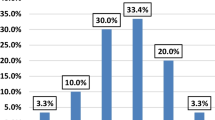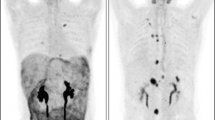Abstract
Purpose
Peritoneal carcinomatosis can be difficult to diagnose using computed tomography (CT). The purpose of this study was to evaluate the role of 2-(fluorine 18) fluoro-2-deoxy-d-glucose (FDG) positron emission tomography (PET) in the detection of peritoneal carcinomatosis.
Methods
We reviewed the CT and FDG PET radiological reports and clinical charts of 18 patients with peritoneal carcinomatosis and 17 cancer patients without peritoneal carcinomatosis. We also assessed FDG PET scans from 20 healthy volunteers as a baseline study. The maximum standardised uptake values (SUVmax) over peritoneal lesions in cancer patients and over the area of most intense intestinal uptake in healthy volunteers and cancer patients without peritoneal carcinomatosis were measured.
Results
The sensitivity and positive predictive value (PPV) of combined FDG PET and CT were superior to those of CT alone for the detection of peritoneal lesions (sensitivity: 66.7% vs 22.2%, p<0.025; PPV: 92.3% vs 50.0%, p<0.05). The most frequent pattern of FDG uptake in patients with peritoneal carcinomatosis was abnormally intense focal uptake near the abdominal wall. An SUVmax threshold of 5.1 produced a diagnostic accuracy of combined FDG PET and CT of 78%. The additional information provided by FDG PET allowed a more accurate diagnosis in 14 patients (40.0%), and led to alteration of the therapeutic strategy in five (14.3%) of the enrolled cancer patients.
Conclusion
We found that use of an intra-abdominal FDG uptake cut-off value for SUVmax of >5.1 assists in the diagnosis of peritoneal carcinomatosis. FDG PET may play an important role in the clinical management of patients with suspected peritoneal carcinomatosis.






Similar content being viewed by others
References
Walkey MM, Friedman AC, Sohotra P, Radecki PD. CT manifestations of peritoneal carcinomatosis. Am J Roentgenol 1988;150:1035–1041
Ha HK, Jung JI, Lee MS, Choi BG, Lee MG, Kim YH, Kim PN, Auh YH. CT differentiation of tuberculous peritonitis and peritoneal carcinomatosis. Am J Roentgenol 1996;167:743–748
Nelson RC, Chezmar JL, Hoel MJ, Buck DR, Sugarbaker PH. Peritoneal carcinomatosis: preoperative CT with intraperitoneal contrast material. Radiology 1992;182:133–138
Jacquet P, Jelinek JS, Steves MA, Sugarbaker PH. Evaluation of computed tomography in patients with peritoneal carcinomatosis. Cancer 1993;72:1631–1636
Ricke J, Hosten N. Peritoneal carcinomatosis. Abdom Imaging 1997;22:235–236
Chou CK, Liu GC, Chen LT, Jaw TS. MRI manifestations of peritoneal carcinomatosis. Gastrointest Radiol 1992;17:336–338
Matsushita M, Hajiro K, Takakuwa H, Nishio A. Transvaginal versus transrectal ultrasonography in the diagnosis of peritoneal carcinomatosis. Am J Gastroenterol 2000;95:1381
Rioux M, Michaud C. Sonographic detection of peritoneal carcinomatosis: a prospective study of 37 cases. Abdom Imaging 1995;20:47–51; discussion 56–57
Goerg C, Schwerk WB. Malignant ascites: sonographic signs of peritoneal carcinomatosis. Eur J Cancer 1991;27:720–723
Stell DA, Carter CR, Stewart I, Anderson JR. Prospective comparison of laparoscopy, ultrasonography and computed tomography in the staging of gastric cancer. Br J Surg 1996;83:1260–1262
Hamacher K, Coenen HH, Stocklin G. Efficient stereospecific synthesis of non-carrier-added 2-(18F)-fluoro-2-deoxy-d-glucose using aminopolyether supported nucleophilic substitution. J Nucl Med 1986;27:235–238
Leisenring W, Alonzo T, Pepe MS. Comparisons of predictive values of binary medical diagnostic tests for paired designs. Biometrics 2000;56:345–351
Inoue T, Koyama K, Oriuchi N, Alyafei S, Yuan Z, Suzuki H, Takeuchi K, Tomaru Y, Tomiyoshi K, Aoki J, Endo K. Detection of malignant tumors: whole-body PET with fluorine 18 α-methyl tyrosine versus FDG—preliminary study. Radiology 2001;220:54–62
Turlakow A, Yeung HW, Salmon AS, Macapinlac HA, Larson SM. Peritoneal carcinomatosis: role of 18F-FDG PET. J Nucl Med 2003;44:1407–1412
Drieskens O, Stroobants S, Gysen M, Vandenbosch G, Mortelmans L, Vergote I. Positron emission tomography with FDG in the detection of peritoneal and retroperitoneal metastases of ovarian cancer. Gynecol Obstet Invest 2003;55:130–134
Turlakow A, Yeung HW, Macapinlac HA, Nunez RF, Sanchez AF, Larson SM. Peritoneal carcinomatosis: the role of FDG-PET. J Nucl Med 2000; Suppl abstr:S36
Lin EC, Lear J, Quaife FA. Metastatic peritoneal seeding patterns demonstrated by FDG positron emission tomographic imaging. Clin Nucl Med 2001;26:249–250
Lin EC. “Straight line” sign of diffuse peritoneal carcinomatosis on sagittal FDG positron emission tomographic images. Clin Nucl Med 2002;27:735–736
Sheth S, Horton KM, Garland MR, Fishman EK. Mesenteric neoplasms: CT appearances of primary and secondary tumors and differential diagnosis. Radiographics 2003;23:457–473
Healy JC, Reznek RH. The peritoneum, mesenteries and omenta: normal anatomy and pathological processes. Eur Radiol 1998;8:886–900
Shreve PD, Bui CDH. Normal variants in FDG-PET imaging. In: Wahl RL, ed. Principles and practice of positron emission tomography. Philadelphia: Lippincott Williams & Wilkins; 2002:111–136
Pannu HK, Bristow RE, Montz FJ, Fishman EK. Multidetector CT of peritoneal carcinomatosis from ovarian cancer. Radiographics 2003;23:687–701
Raptopoulos V, Gourtsoyiannis N. Peritoneal carcinomatosis. Eur Radiol 2001;11:2195–2206
Huang SC. Anatomy of SUV. Standardized uptake value. Nucl Med Biol 2000;27:643–646
Zhuang H, Pourdehnad M, Lambright ES, Yamamoto AJ, Lanuti M, Li P, Mozley PD, Rossman MD, Albelda SM, Alavi A. Dual time point 18F-FDG PET imaging for differentiating malignant from inflammatory processes. J Nucl Med 2001;42:1412–1417
Smith GT, Hubner KF, McDonald T, Thie JA. Cost analysis of FDG PET for managing patients with ovarian cancer. Clin Positron Imaging 1999;2:63–70
Arulampalam T, Costa D, Visvikis D, Boulos P, Taylor I, Ell P. The impact of FDG-PET on the management algorithm for recurrent colorectal cancer. Eur J Nucl Med 2001;28:1758–1765
Saga T, Torizuka T, Ouchi Y, Nishizawa S, Yonekura Y, Ochi H, Miyama M, Shiomi S, Uno K, Konishi J, Torizuka K. Clinical usefulness and cost-effectiveness of FDG-PET in the staging and follow up of patients with gynecological malignancies—an analysis based on multi-center survey. Radioisotopes 2003;52:11
Acknowledgments
We thank Mr. T. Gibson for revising the text and Mr K. Hirono for his technical assistance.
Author information
Authors and Affiliations
Corresponding author
Rights and permissions
About this article
Cite this article
Suzuki, A., Kawano, T., Takahashi, N. et al. Value of 18F-FDG PET in the detection of peritoneal carcinomatosis. Eur J Nucl Med Mol Imaging 31, 1413–1420 (2004). https://doi.org/10.1007/s00259-004-1577-y
Received:
Accepted:
Published:
Issue Date:
DOI: https://doi.org/10.1007/s00259-004-1577-y




